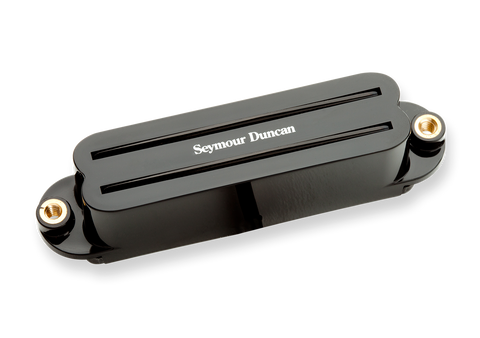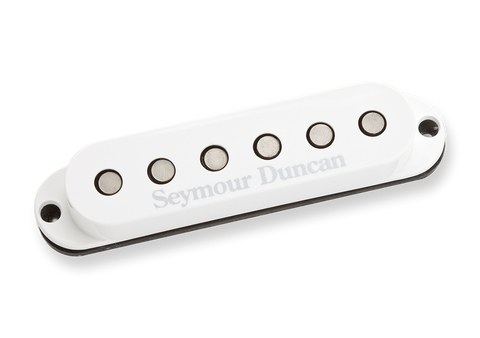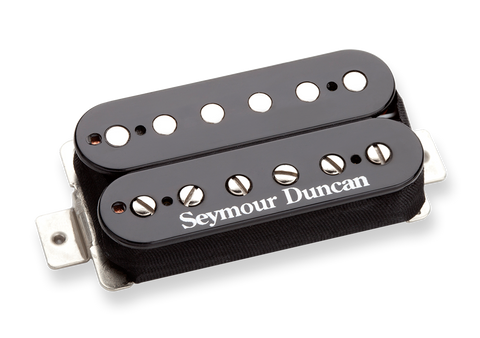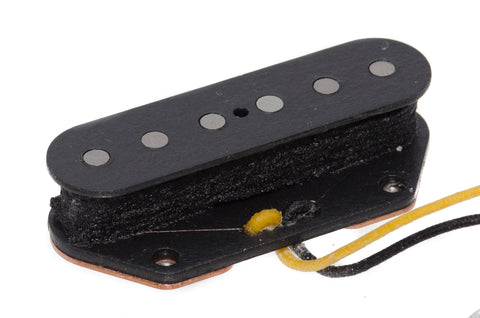From the manufacturer:
Though he has dozens of amazing guitars, since 1986 Slash has used pretty much one very special Les Paul ® for all recording. The Alnico II Pro Slash was designed to give Slash's other Les Paul guitars-what he calls his "live guitars"-the exact tone of this legendary instrument.
Application
Warm, moderate output humbucker. Recommended for jazz, blues, and classic rock.
Description
Like the standard APH-1 Alnico II Pro, this pickup uses an Alnico 2 magnet. However, the Slash model is wound with just enough boosted output to push a stock Les Paul toward the sweet sustain and rude crunch that characterizes Slash's sound as heard on hundreds of tracks. In addition, it comes with some of the same appointments found on the Seymour Duncan pickups in Slash's '86 recording axe, including single-conductor cable, long-legged bottom plate, and wooden spacer. For the true fan, or the player who wants to capture Slash's recorded tone, this pickup is a critical part of the tone chain. This is same pickup found in the newest Gibson® Slash model Les Paul.
Complete setup
The Slash aficionado will use a pair of these pickups to capture that unmistakable tone. This pickup matches well with the SFX-11 Twin Tube Blue all-tube overdrive-distortion stompbox for singing leads and authoritative chording.
Guitars
While designed for use in a Les Paul, this pickup works well in any well-balanced humbucker-equipped guitar. Also works great with hollow and semi-hollow body guitars.
Available Mods
Available in black, zebra, or reverse zebra. The infamous Slash recording guitar has a reverse zebra pickup in the bridge position and a zebra pickup in the neck position. This pickup is available individually or in the zebra/reverse zebra set.
Players
Slash
Best videos/sound clips:
In this video, we hear the Alnico II Pro Slash APH-2 pickup in both the neck and bridge positions in a 1970's Kasuga Les Paul copy through the Fractal Audio Axe FX preamp/processor. First we are treated to the rhythm part played with the APH-2 in the bridge. I find the alnico II magnets in these pickups give the guitar sound a certain smoothness and a nice round top end. In this demo, this guy has dialed in a fairly good reproduction of Slash's sound. At 1:12, we hear the APH-2 bridge pickup playing leads, again, listen to the roundness and definition in the high frequencies. He switches to the neck pickup at 1:27, and he plays some nice slower leads before launching back into bridge pickup pyrotechnics. Interestingly, this particular Kasuga guitar has a bolt-on neck, which should sound very different from a typically set-neck Les Paul, but I don't really hear the difference here. Accurate Slashiness!
This is a cool video that features the APH-2 played by Danny Young entirely in the neck position. Again, I am struck by the "roundness" of this pickup, especially in the neck position. It sounds "woody" to me, like we can hear the character of the guitar itself coming through the pickup. He starts with some nice volume swells in a very "Floydy" backing track. Really tasteful stuff throughout, but watch for the two handed section at 2:21 and the feedback work toward the end. Also, looks like he needs a new toggle switch knob! I really enjoy the playing without the pick at 3:00. A nice demonstration of the APH-2 in the neck position.
Here's another video from Seymour Duncan and Danny Young, this time featuring the APH-2 exclusively in the bridge position. This demo is the "Classic Rock" version, as opposed to the "Hard Rock" version. He starts the demo with some nice feedback work, before playing a riff in the lower register. At 0:37, he starts playing leads, and we definitely get the Slash vibe from this pickup. Nice high frequency smoothness. He turns on the wah pedal at 0:50, giving us a sort of "You Could Be Mine" flavor, before incorporating the "Sweet Child O' Mine" lick into his improvisation. Very nice. At 2:00, we hear the APH-2 alone, with no backing track, playing with feedback. Nice Slash tone and feel.
This is a video featuring the APH-2 in a more "Hard Rock" context. Again, it's Danny Young, this time in a drop D tuning. The demo starts immediately with a build up section that leads up to a lead at 0:13. We hear the APH-2's nice treatment of the high end, smooth and round. At. 0:27, we hear a heavy drop D riff and at 0:53, he explodes into some two handed shreddy madness. 1:03 returns to the heavy riffage, and again switches to the two handed ridiculousness at 1:08. There's some nice harmony guitar soloing at 1:25, and we hear the way the APH-2 cuts through the mix well. The rest is basically interleaving the heavy drop D riff with the two handed sections to the end. Very nice.
Here's a demo that is interesting because the APH-2's have covers on them. It starts with some high gain playing in the neck position at 0:05, and at 0:42, we get some two handed playing. At 1:16, he switches to the bridge pickup, withe cool things happening at 1:39. There's a nice climbing section that begins at 1:50, and he switches back to the neck pickup for some nice singing lines at 2:04. Listen to the smoothness. listen to the highs and high mids. Good stuff. He returns to the bridge pickup at 2:47, staying there until the end of the video. The APH-2 holds it own even in a metal context. Surprising.
This demo starts at 1:10, playing some clean open chords on his Epiphone Les Paul Custom through his fender Hot Rod Deluxe Amp until. At 1:46, he switches to the neck pickup alone, and playes some clean bluesy leads, until 2:51, when he rolls the tone control all the way off and plays some jazzy chords. We are treated to some more playing on both pickups at 3:40, and he lets us hear the bridge pickup alone at 4:46, rolling the tone control all the way off at 4:37. He kicks on his Ibanez TS9 Tube Screamer (which appears to be modded to be true bypass) at 5:00, switching to the neck pickup, letting us hear this combination with the tone rolled all the way off at 5:48. At 6:22, we hear both pickups through the TS9, switching to the bridge pickup by itself at 6:54. At 7:54, he clicks the TS9 off and clicks the JHS Angry Charlie on, and we hear some hi gain playing on the bridge pickup. We hear this same combination with the tone rolled off at 9:00. He switches to the neck pickup at 9:50, and we return to clean land at 10:40 with the bridge pickup. He lets us hear how the pickup reacts to the same lick after this, playing the lick he just played clean with the Angry Charlie on at 10:55. He ends the video by playing some nice drop-d stuff with the bridge pickup through the Angry Charlie. This video illusrates all the killer sounds and sustain available with the APH-2, even with a comparatively low-cost guitar.
This video is unique because it compares the APH-2 to the Gibson 57 Classic, which are the stock pickups in a Gibson 1961 Reissue SG. He's playing through a Marshall JCM 900 half stack, and sometimes plays through an Ibanez TS9 Tubescreamer, and sometimes a BlackStar HT-Dual Tube Distortion pedal. He starts the video with an explanation of his gear in French, and at 2:30 he starts by playing the 57 Classic with a clean sound. At 2:47 we hear the same musical example with the APH-2. I hear a difference in the way the APH-2 handles the high and high mid frequencies. It's a brighter pickup. He turns on the TS9 at 3:20, and we hear a blues rhythm played on with the 57 Classic in a kind of crunch sound. He swithes to the APH-2 at 4:11, using a simliar sound, and plays a similar blues-based example. At 5:50, we hear the 57 Classic with a high gain sound, and at 6:23 we hear the APH-2, with some nice wah work at 7:27. I like how the APH-2 treats the high end, it sounds smoother through the distortion to my ear. There's a section with even more gain starting at 8:15 for the 57, and 8:45 for the APH-2. The 57 sounds brittle to me, where as the APH-2 sounds rounder and again, smoother in the upper frequencies. He plays some detuned metal riffs through both pickups starting at 9:45, and to me it is obvious that he enjoys playing through the APH-2, because throughout the video, he plays on it for about double the time he plays on the 57 Classic. Nice sounds.
In this demo, this guy has the APH-2's in a 2001 Yamano Spec Gibson R9. He appears to be playing through a Diezel VH-4. The video starts with a quick clean solo featuring the APH-2 in the bridge position. After a bit of explanation, he begins an exploration of the clean sounds available in each position. The clean bridge demo starts at 1:19, he moves to the middle at 2:03, and to the neck position at 2:54. He does a great job playing the same examples so we can compare the differences between positions. At 3:50, he switches to the distorted channel of the amp, again going through each of the pickup positions, playing very nearly the same things. Check out 4:41 for some nice harmonics that begin a cascade into sheets of ripping fast notes. I am struck by the clarity here, and the sustain. Listen to the long sustainy goodness at 7:00, in the middle of the middle pickup demo, and again during the neck pickup demo that starts at 7:41. Great sounds, great playing.
Here's a video featuring the APH-2 in a Gibson Les Paul Classic played through a wah pedal into a Marshall SL5. After a cool section showing us some of the flaminess of the maple top, he starts to play at 2:51 with some single note playing on the neck pickup, then he chords for a bit before unleashing the distortion on the bridge pickup at 4:12. The wah is kicked on at 4:49, with some tasty pentatonic playing. Cool things happen at 5:48, where he illustrates the amazing sustain these pickups have, first starting with the neck pickup, then clicking to the bridge pickup at 6:27, before playing some signature slash licks to end the video. So much sustain!!
This is a demo video that has the APH-2 in a Les Paul Copy Guitar of some type being played through a Laney IRT120H IronHeart half stack. The majority of the video is played with the pickup selector in the bridge position, only flipping to the neck once, at 3:58 for a bit before kicking on his octave pedal at 4:08. He plays with the neck pickup and octave pedal for a few seconds before returning the selector the bridge position, keeping the octave pedal on. At 4:44, he turns the octave off. The rest of the video is just the bridge pickup. I include this one mostly for the nice straight ahead rock sound that is possible with the APH-2 set. At times this guy really nails the George Thoroughgood tone without having ANY of the gear the George had! Very Cool.
Here is a really nice video that compares the stock pickups in a 2012 Les Paul Traditional (57 Classics), with the APH-2's. After playing for about a minute letting us hear the 57 Classics in each pickup position, he lets us hear the same blues rhythms and leads played with the APH-2's. From 2:00 to 2:59, we hear a the 57 Classics playing a clean rhythm in each pickup position, followed by the APH-2's playing the same clean rhythm. I enjoy the way the Slash pickups round out the high end, especially in the neck pickup example from 1:42 to 2:00. It really calms down some of the 57 Classic harshness. Good Stuff.
This video just illustrates again, how the APH-2 can make a low-cost guitar sound like a high-cost one. This is a Vintage brand Les Paul-style guitar being played through a Line6 POD. He goes through many sounds, plays clean and dirty, rhythm and lead. The APH-2 sounds good in all these applications. I like the section from 3:21 to 4:30, with the pickup selector in the middle position. So much sustain! Really nice playing, again, allowing us to hear the clarity and roundess of the highs and high mids of the APH-2.
Here is a look at Slash's original Appetite for Destruction recording guitar, equipped with the original Alnico II Pro humbuckers. Seymour Duncan himself is in this video describing a feedback issue that the pickup is having and walking through his procedure for fixing it. After making various measurements and removing the pickup, Seymour re-pots the pickup by dipping it in wax and agitating it. He then talks about the importance of waxing and how it works to solidify the components of the pickup to reduce unwanted feedback and noise. Pretty interesting stuff!














